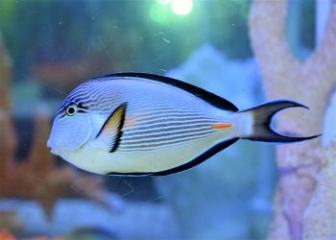Phoenix Fish - Learn about beautiful, colorful, easy-to-raise ornamental fish
Blog | by
Discover information about Phoenix fish, a colorful ornamental fish with graceful swimming style, friendly, easy to raise, easy to care for, and reasonable price.
If you are looking for a beautiful, cheap, easy to raise, easy to breed ornamental fish for your aquarium, choose the Phoenix fish . With its brilliant appearance and friendly temperament, the Phoenix fish will help you decorate your aquarium more vividly and uniquely.
In today's article, nice fish will help you learn detailed information about Phoenix fish, including origin, habits, care and price for each separate line. Let's find out now!
Information about phoenix fish :
| Scientific name | Mikrogeophagus ramirezi |
| Common name | Phoenix fish, blue ram fish, yellow ram fish, dwarf ram Cichlid fish |
| Source | Fish endemic to South America |
| Class | Actinopterygii - Ray-finned fishes |
| Set | Perciformes - Sea bass |
| Surname | Cichlidae - Emperor fish, tilapia |
| Spend | Microgeophagus |
| Lifespan | |
| Size | 4 - 6 cm |
Where do phoenix fish come from?
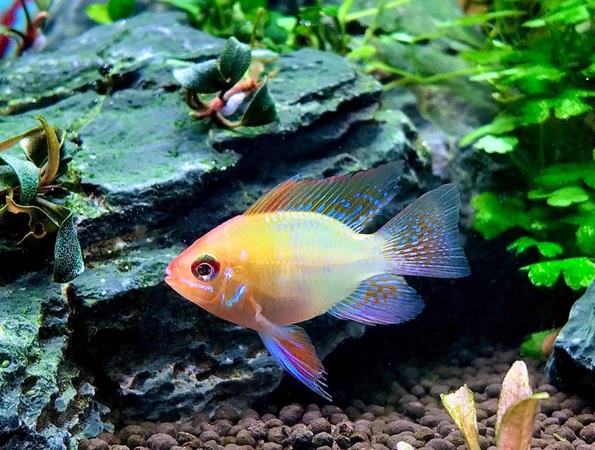
The phoenix fish is a freshwater aquarium fish endemic to South Asia.
The phoenix fish is endemic to South America, especially the Orinoco River basin in Venezuela and Colombia. They often live in canals, small streams or ponds with slow currents, warm temperatures, soft water, low pH, especially in water with many layers of rotten leaves, fine sand or aquatic plants.
This fish was first scientifically described in 1948 by ichthyologists George S. Myers and R.R. Harry.
Nowadays, thanks to its bright, eye-catching appearance and gentle temperament, this fish is very famous in the aquatic world and especially in the Vietnamese ornamental fish market.
Phoenix fish appearance and how to distinguish male and female fish
General physical characteristics of phoenix fish
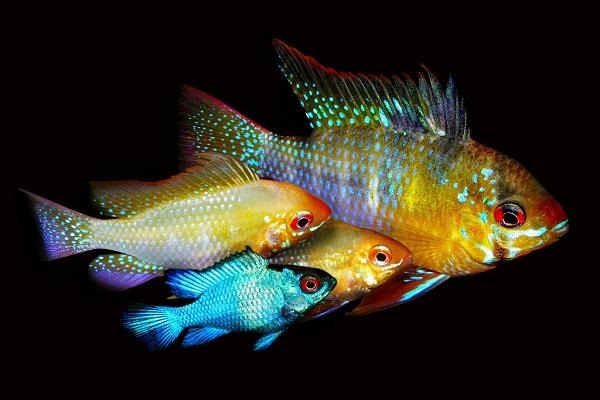
Phoenix fish come in many different colors.
Although the Phoenix Fish has many color variations, they all have the following common physical characteristics:
- Body : The fish's body is oval, slightly flattened on both sides, looking very elegant.
- Size : 4 - 8 cm, depending on the line.
- Head : Small, small mouth facing forward, eyes red or orange.
- Dorsal fin : Extends from mid-back to tail, pointed or flared depending on the strain.
- Caudal fin : Wide spread.
- Color : Has iridescent fins in blue, yellow, red, orange, some may have additional black spots or stripes.
- Swimming style : Gentle, slow and graceful.
Distinguishing between male and female phoenix fish
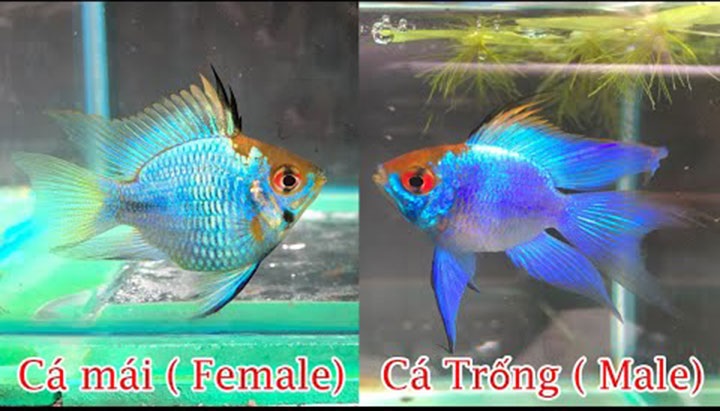
Compare female and male phoenix fish.
Below are some differences that will help you easily identify which is a male or female phoenix fish.
| Characteristic | Male phoenix fish | Female phoenix fish |
| Size | Bigger than female | Smaller than male fish, shorter body, looks fatter |
| Color | More colorful | Lighter, but the belly area is often pink or red, this is also a sign to help you know the female is mature and ready to reproduce. |
| Dorsal fin | The dorsal spines are sharper and longer. | Fin spines are shorter and more blunt. |
| Behavior | Like to "show off" and chase female fish | No chasing behavior, swimming more smoothly and gracefully. |
Phoenix fish behavior
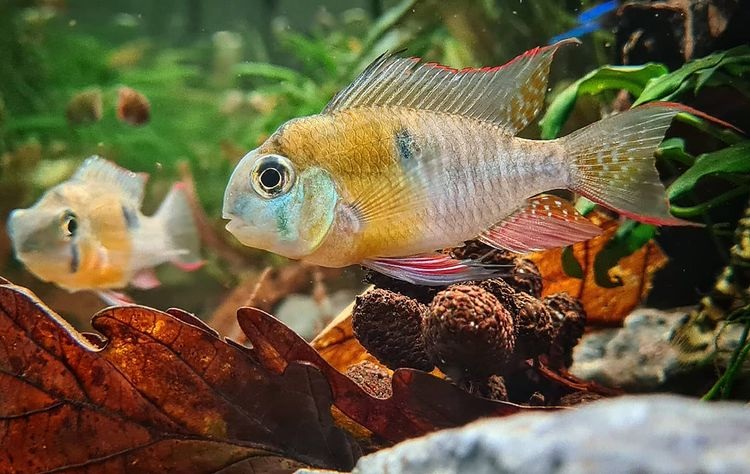
Phoenix fish are quite gentle and peaceful.
Phoenix is an ornamental fish that not only has a beautiful appearance and colorful colors, but it also has extremely interesting habits. Let's learn more below.
Gentle
The phoenix is the most gentle species in the Cichlid family, it almost never fights or is aggressive with other small fish. You can also raise phoenix fish with many types of ornamental fish such as Neo tetra fish , mouse fish , Molly fish ,...
Like to show off
Male phoenix fish love to show off to females or even other males. They will often shiver, spread their fins, or swim in circles when trying to attract a female's attention.
Highly territorial when it comes to breeding
Normally this fish is quite docile, however when it comes to breeding season, especially when the eggs have been placed in the nest, they will tend to protect their territory, chasing other fish away from their nest or shelter.
Smart
The phoenix fish is quite intelligent and can remember the faces of people who feed them, and when it sees you coming near, it will swim over and "dance" happily. There are even many hungry fish that know how to swim back to the glass to wait for people to come and feed them.
Like quiet places
This fish prefers calm waters with lots of driftwood, aquatic plants or rock caves to provide a sense of security. They also do not like places with too much light or strong currents.
The most standard technique for raising phoenix fish
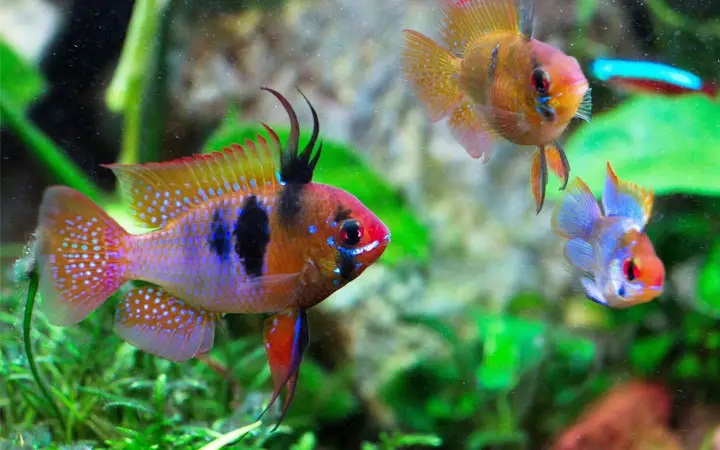
Phoenix fish like to live in tanks with lots of aquatic plants.
If you want to raise healthy phoenix fish, beautiful colors, and good reproduction, please refer to some of the techniques below.
Standard phoenix fish pond design
- Size : Minimum 50 - 60 L for a pair of male and female fish.
- Water filtration system : Choose a quiet filter.
- LED light : Soft light, not too bright.
- Water temperature : 26 - 30 degrees Celsius.
- Hardness : 2 - 10 dGH, soft water.
- pH : 6.0 - 7.2, slightly acidic water is the best.
- Aquarium decoration : Plant many aquatic plants with strong roots to help fish relax or make nests to breed, decorate with driftwood, rocks, hiding places, choose fine sand as the substrate because this fish species loves to dig in the sand.
What do phoenix fish eat?
The phoenix is an omnivorous fish, it is easy to eat, not demanding. Some good, convenient foods that you can refer to for feeding the fish are as follows:
- Fresh food : Artemia, bloodworms, daphnia, red worms, clean, processed.
- Pellet feed : Choose the type specifically for colored ornamental fish.
Because of their omnivorous and gluttonous nature, you must know how to balance the amount of food, do not let the fish eat too much, it is easy to get intestinal diseases and also pollute the water in the tank.
Monitor fish behavior and health
Phoenix fish are also susceptible to some diseases related to parasites, fungi, intestinal tract, etc. Here are some common diseases in them, let's learn together to know how to handle them promptly to help your fish stay healthy.
| Disease name | Reason | Symptom | Treatment and management |
| Phoenix fish with fungus |
Dirty water, lots of organic waste. Fish scratches lead to fungus growth |
Fish grow white cotton patches on their body Lazy fish, like to lie at the bottom, lethargic people |
Separate sick fish from the tank. Change clean water, increase filter capacity and aeration. Use antifungal drugs such as anti fungus, methylene blue... |
| Phoenix fish with anchor worm |
Parasites are present in raw bait fish. Polluted water |
Fish often rub themselves against rocks, aquatic plants, and tank walls. Saw white, thread-like anchor parasites attached to the fish's body. Fish with folded fins, not flexible |
Isolate sick fish. Use tweezers to remove the parasite. Bathe in diluted salt water at a ratio of 1 - 2 g/l for about 5 - 10 minutes, bathe for about 3 - 4 consecutive days. |
| Phoenix fish has bloated belly |
Bacterial endocarditis. Fish eat too much |
The fish's belly is bulging and its scales stand up. Fish gasping for breath, not eating |
This disease is very difficult to cure if left too late. Isolate the fish in a separate tank. Use antibiotics, change water every day. |
Reproduction in phoenix fish
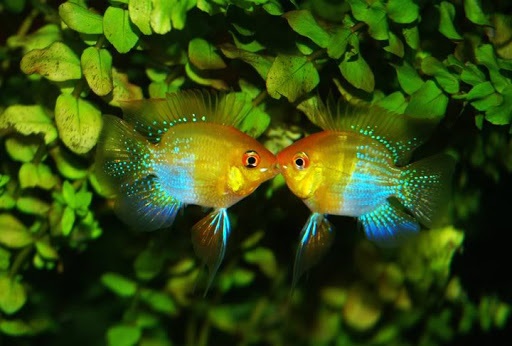
Male and female phoenix fish should be separated into a separate tank to prepare for breeding.
Among ornamental fish, perhaps the phoenix is the fish that knows how to take care of its young the best, this is quite rare.
Conditions for phoenix fish to reproduce
Phoenix fish will breed if they meet the following basic requirements:
- Reproductive age Male and female fish will reach reproductive age when they are 5 - 6 months old or older.
- Breeding tank capacity Minimum 40L for a pair of fish.
- Stable water parameters.
- Varied diet
Reproduction process in Phoenix fish
- First, the male fish will vibrate, courting the female fish.
- After agreeing, both will clean the nest by fanning sand, cleaning rocks, leaves, etc.
- The female fish lays rows of eggs, then the male fish swims after and fertilizes them externally, each time the female fish lays 100 - 200 eggs.
- Male and female fish take turns fanning the water with their fins to protect their nest.
- After 3 - 4 days, the fish will hatch.
Caring for baby phoenix fish (fry)
After the fry hatch, the father and mother continue to protect their fry at all times. You can feed the fry with da bo, boiled egg yolk, or newly hatched artemia.
Phoenix fish price list
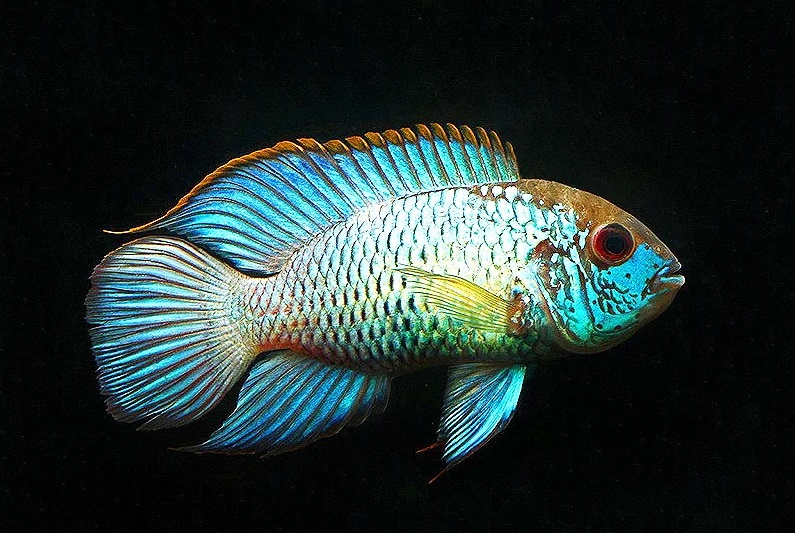
Acara phoenix fish with attractive blue color.
Phoenix is a fairly cheap ornamental fish, usually ranging from a few dozen to more than 100 thousand. Right below, we have compiled a list of Phoenix fish prices in Vietnam, newly updated, please refer to it.
| Phoenix fish line | Reference price (VND/piece) | Note |
| German Ram | 30.000 - 50.000 | Popular, purebred, easy to raise. |
| Blue Phoenix | 15.000 - 40.000 | Metallic blue fish, easy to breed |
| Golden Phoenix | 15.000 - 30.000 | The fish is bright yellow and easy to raise. |
| Acara Phoenix | 50.000 - 150.000 | Big fish. |
| Fire-bellied Phoenix | Over 400,000 | Rare line, need to pre-order |
5 Most Beautiful and Popular Phoenix Fish in Vietnam
Currently, in the Vietnamese ornamental fish market, some types of phoenix fish with colorful colors are hot as follows:
Five-color phoenix fish
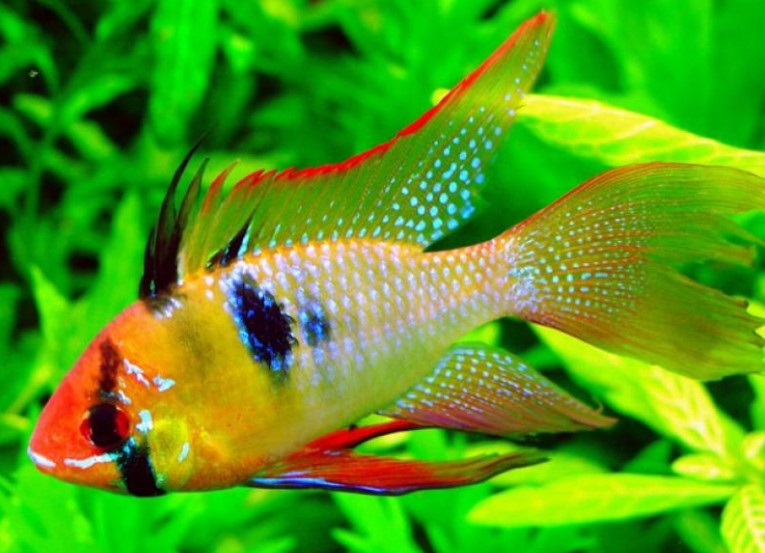
A colorful, sparkling phoenix fish.
This is the most colorful and attractive variant of the phoenix fish, carefully bred between lines such as German Blue Ram, Gold Ram, Balloon Ram and developed mainly from fish farms in Asia.
Characteristic:
- Color: Mixing many colorful colors such as blue, orange red, yellow, purple creates a shimmering, eye-catching appearance like a rainbow.
- Shape : similar to the traditional phoenix line with oval body, soft fins, graceful swimming.
Firebellied Phoenix Fish
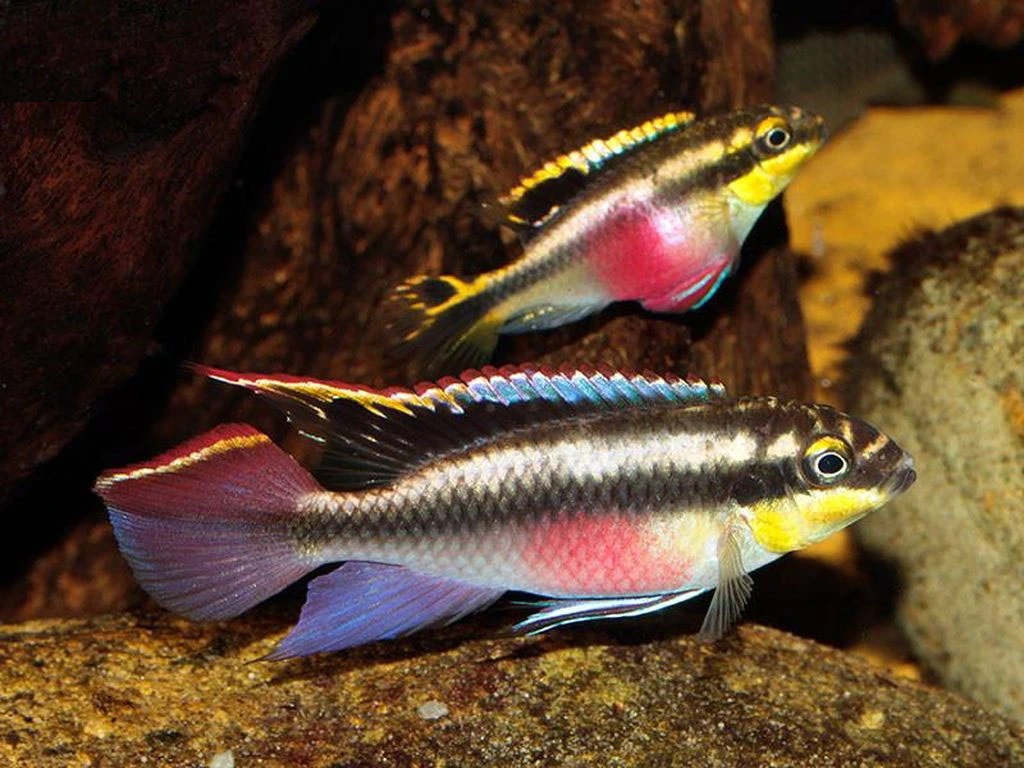
The most prominent and popular variant of the Mikrogeophagus ramirezi dwarf phoenix line with a long, slender body, colorful colors combined with a red patch on the belly.
Characteristic:
- Color : The body is gray, the belly is silvery white, there is a red patch on the belly, the head of the fish is a mixture of dark black and bright yellow. The dorsal fin is metallic black, with metallic blue edges. The caudal fin and ventral fin are sparkling purple.
- Size : 4 - 6 cm, slim body, soft fan tail.
German Blue Ram
.jpg)
A German Blue Ram fish with a super beautiful metallic blue color.
A variant of the phoenix fish bred in Germany, through genetic selection to create individuals with a uniform iridescent blue color, and this fish species does not exist in nature. There are many different names such as German Blue Ram, German Blue Ram.
Characteristic :
- Color : Metallic blue body with metallic spots, fins with light red or orange edges.
- Size : 4 - 6 cm, appearance similar to traditional phoenix
- Breeding : Can be bred in captivity if conditions are met.
German Gold Ram Balloon
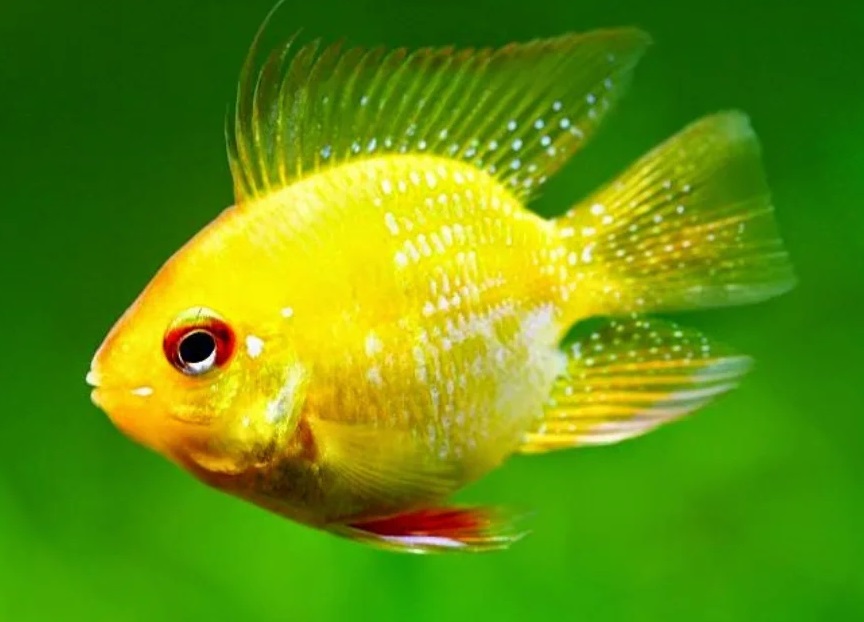
A dwarf golden phoenix fish.
The Golden Phoenix Fish, also known as the German Gold Ram Balloon, is a very beautiful variant of the Ram cichlid line with a brilliant appearance. They are also known as the Golden Balloon Ram, Golden Phoenix Ram.
Characteristic :
- Color : The whole body is shiny yellow, sometimes mixed with a little metallic blue or red.
- Shape : Shorter body, rounder and rounder than normal Ram fish, looks plump.
- Size : 4 - 6 cm.
Bolivian Phoenix Fish
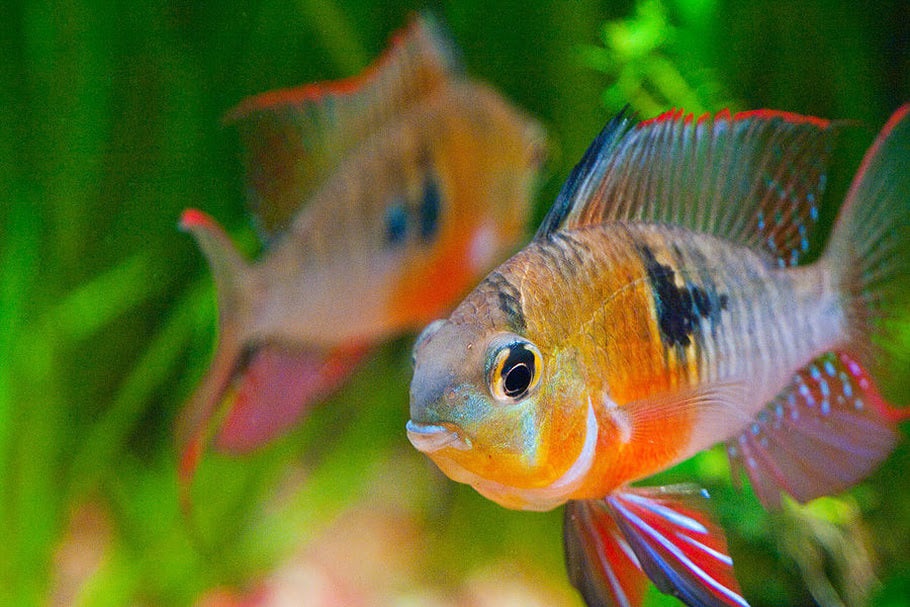
Bolivian phoenix fish.
A very popular variant in the phoenix fish line because of its beautiful color, gentle temperament and easier to raise than the German Ram line.
Characteristic :
- Color : The body is golden brown, turquoise or light pink depending on the light, on the cheekbones of the fish there is a prominent orange-red streak, the dorsal fin has a red border.
- Size : 6 - 8 cm
- Lifespan : 4 - 5 years.
With the information that nicefish.net has shared above, we can see that the Phoenix fish is a perfect choice to bring unique beauty to your aquarium. With rich colors, easy to raise, easy to breed, cheap price, this fish deserves to be in the top national ornamental fish.
In the Blog section , we also provide many interesting articles about other beautiful and hot ornamental fish species. Please follow along to expand your knowledge about the aquatic world!
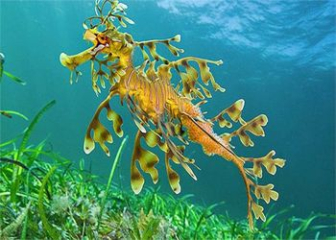
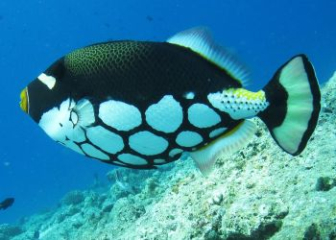
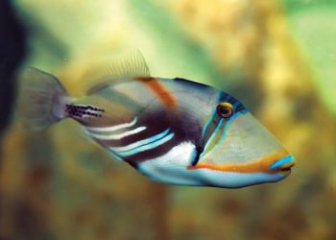
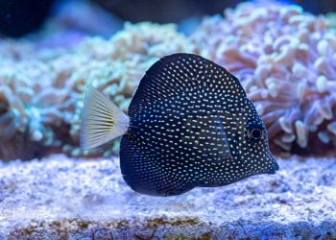
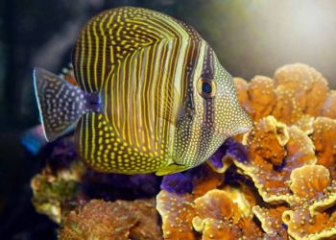
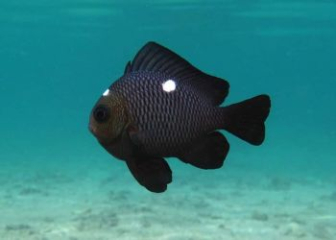







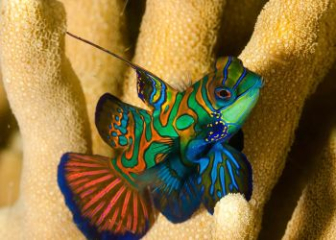

_350x250.jpg)


